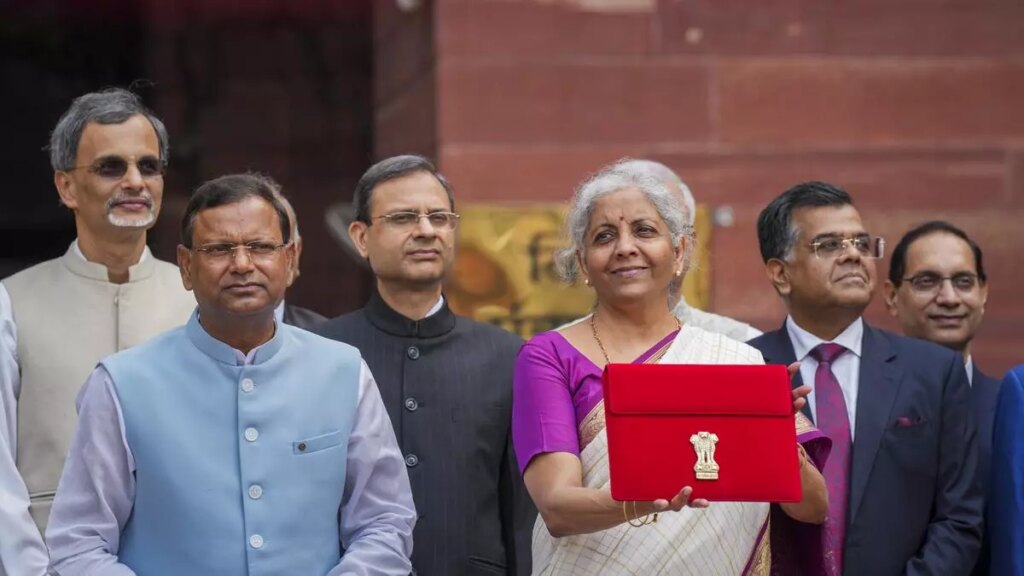Editorial. Cautious and conservative – The Hindu BusinessLine

To give away without being profligate seems to have been the guiding principle of the Union Budget presented by the NDA government after winning a third term in the recent Lok Sabha elections. Any apprehension that the thin margin of victory would prompt it to abandon fiscal consolidation was allayed by the Budget’s headline numbers. Finance Minister Nirmala Sitharaman has indulged in what some may call as populist experiments targeted at the youth, farmers, women, home-buyers and other interest groups, apart from promising generous handouts to States ruled by its critical allies. But this has been managed without veering off the promised fiscal consolidation path, which is good.
The Centre expects the fiscal deficit to be contained at 4.9 per cent for FY25, lower than 5.6 per cent in the FY24 actuals. A bumper dividend from Reserve Bank of India (about 0.4 per cent of GDP) no doubt helps with this tightening. Big-picture numbers in the Budget carry the stamp of conservatism that characterises the current team at North Block. The 14.6 per cent projected growth in revenue receipts is backed up by 11 per cent growth in tax mop-ups, an easily achievable number. The capital expenditure outlay of ₹11.1 lakh crore (17 per cent growth) is retained from the interim Budget, while revenue expenses are budgeted for just a 6 per cent rise, suggesting belt-tightening in the running of the government. PSU divestment proceeds, historically used as a balancing figure, have been prudently left out. The nominal GDP growth assumption of 10.5 per cent is realistic too. Overall, the Budget math offers enough ammunition for the government to continue its lobbying with global rating agencies for a long-overdue sovereign rating upgrade. Foreign investors sitting on the fence after the recent inclusion of Indian sovereign bonds in global indices, now have one more reason to take the plunge.
While the Budget has been frugal with expanding overall outlays, it has not been able to resist the temptation to spread its allocations thin over a multitude of new schemes. For instance, it is right to pay special attention to India’s youth and their employment prospects. Allocations for industrial training institutes and subsidised loans for upskilling and education are good ideas. Given the success of a similar scheme during Covid, government support for EPF contributions of new employees in the first two years, is also understandable. But it isn’t clear why these initiatives need to be supplemented by a direct cash dole (equating to one-month’s salary) to 2 crore formal sector employees. A new interest subvention scheme for home-buyers also seems superfluous, when there’s a mammoth ₹84,000 crore for PM Awas Yojana Rural and Urban. The allocations make one wonder if the proliferation of new schemes targeted at women, youth, children, farmers etc comes at the cost of older, proven schemes such as Jal Jeevan Mission, PM Gram Sadak Yojana, Krishi Sinchai Yojana and MGNREGA. Despite being stated priority areas for this government, allocations towards defence, highways and railways remain more or less flat.
There are several Budget announcements that do not have material revenue implications, but can vastly improve ease of doing business or ease of living. Taking a leaf out of the successful ECLG scheme to offer guarantees of up to ₹100 crore to individual MSMEs for project loans, with guarantee fee borne by the borrower, can aid scaling up of MSMEs. The nudge to banks to replace their age-old models of collateral-based MSME lending with contemporary models that use digital footprint can prove game-changing. Abolishing angel tax will remove a key irritant in start-up funding and hopefully perk up FDI inflows. The promise to set up more benches of NCLT and DRT should reduce the backlog of unresolved debt recovery cases. Individual taxpayers will surely breathe a sigh of relief if the limitation on reopening of past assessments is set at 5 years, instead of the present 10. Though a review of the Income Tax Act 1961 to make it simpler is the wish of every taxpayer, it needs mention that the Direct Tax Code 2010 has not yet seen the light of the day.
The hike in Securities Transaction Tax on derivatives trades and capital gains tax on equities, though not very popular with stock markets, may serve the larger purpose of quelling speculation. Uniform holding periods of 12 months and 24 months respectively for listed and unlisted securities, and the single long-term capital gains tax rate of 12.5 per cent across equity, debt, property and gold, with no indexation benefits, may level the playing field between physical and financial assets.
Finally, it is a disappointment that yet another Budget has passed without a material lowering of tax incidence for the individual taxpayer, who does all the heavy lifting on tax revenues and thus bankrolls welfare spend for other interest groups. While the higher standard deduction and tweaking of slabs under the new regime are welcome, the estimated revenue foregone of ₹29,000 crore from direct tax changes, suggests only a marginal boost to middle-class incomes.








